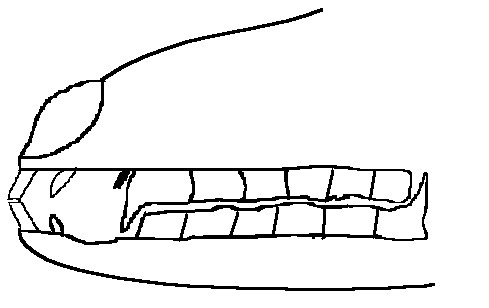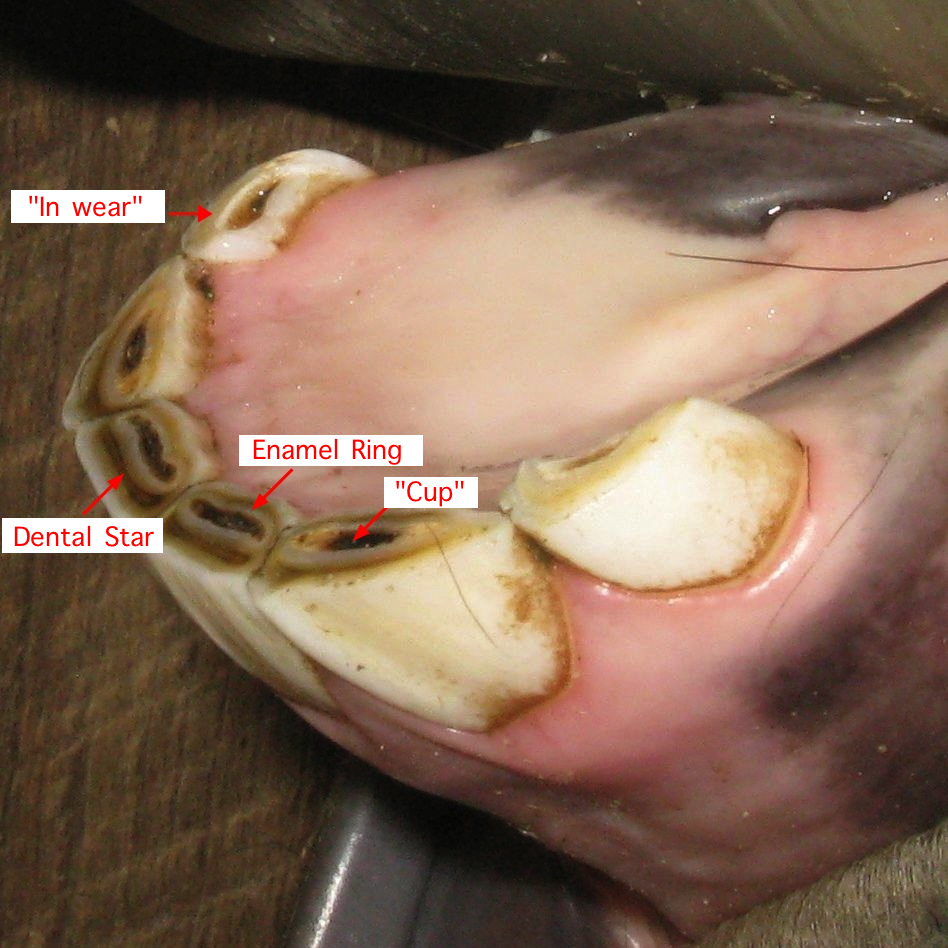Dmva Champs Quiz #3 - Teeth

This quiz on horses teeth covers a lot of material from the C and B-A manual, as well as other online sources.
- 1.
Two stable vices that can hurt a pony’s teeth are:
- A.
Pawing and weaving
- B.
Wood chewing and pawing
- C.
Stall kicking and wood chewing
- D.
Cribbing and wood chewing
Correct Answer
D. Cribbing and wood chewingExplanation
Cribbing and wood chewing are two stable vices that can hurt a pony's teeth. Cribbing refers to a behavior where a horse grasps a solid object, such as a fence or stall door, with its incisor teeth, arches its neck, and pulls against the object while sucking in air. This can cause wear and tear on the pony's teeth. Wood chewing, on the other hand, involves the pony gnawing on wooden surfaces, which can also lead to dental issues. Therefore, both cribbing and wood chewing can potentially harm a pony's teeth.Rate this question:
-
- 2.
Horses, like humans, have two sets of teeth.
- A.
True
- B.
False
Correct Answer
A. TrueExplanation
Horses have two sets of teeth, one temporary and one permanent. Temporary teeth may also be called "baby" or "milk teeth." Temporary incisors tend to erupt in pairs at 8 days, 8 weeks, and 8 months of age.Rate this question:
-
- 3.
All horses (should) have at least 36 permanent teeth but can have up to ____ depending on the gender and other factors.
Correct Answer
44Explanation
At five years of age a horse has between 36 and 44 teeth. All horses have
Twelve premolars and twelve molars commonly known as cheek teeth or jaw teeth.
Twelve incisors, or front teeth.
Additionally, a horse may have:
Between 4 and 5 canine teeth (tushes, tusks) between the molars and incisors. Generally all male horses have four canines. However, few female horses (less than 28%) have canines, and those that do usually have only one or two, which many times are only partially erupted.
Source(s): http://en.wikipedia.org/wiki/Horse_teethRate this question:
- 4.
Oh boy, what's going on here? Answer: this horse is getting his teeth __________.
Correct Answer
floated
FloatedExplanation
He's getting his teeth floated with a power float tool that does a quick and good job of taking off any hooks or unevenness.Rate this question:
- 5.
What is this space called? It's where the bit goes and is between the inscisors and pre-molars.
- A.
Bit space
- B.
Interdental space
- C.
Galvaynes space
- D.
The cups
Correct Answer
B. Interdental spaceExplanation
The space described in the question is located between the incisors and premolars and is where the bit goes. This space is commonly known as the interdental space.Rate this question:
-
- 6.
what is this arrow pointing at?
- A.
Dental star
- B.
Tusk
- C.
Pulp mark
- D.
Galvayne's Groove
Correct Answer
D. Galvayne's GrooveExplanation
Galvayne's Groove: The Galvayne's groove occurs on the upper corner incisor, producing a vertical line, and is helpful in approximating the age of older horses. It generally first appears at age 10, reaches half-way down the tooth by age 15, and is completely down the tooth at age 20. It then begins to disappear, usually half-way gone by age 25, and completely gone by age 30.Rate this question:
-
- 7.
This horse has a conformation defect in it's mouth. What is it called?
- A.
Parrot Mouth
- B.
Hoof and Mouth
- C.
Bucktoothed
- D.
Sawtoothed
Correct Answer
A. Parrot MouthExplanation
"Parrot mouth" is a result of the upper and lower incisors not meeting because the lower jaw is too short. This condition is rather common and may seriously interfere with grazingRate this question:
-
- 8.
This drawing is showing what problem that can be cured by floating?
- A.
Wave
- B.
Wolf
- C.
Spike
- D.
Hook
Correct Answer
D. HookExplanation
Hooks occur when the molars do not match up in a different way. Usually the upper molars are slightly forward of the lower molars. In the back of the mouth this causes the lower molars to be extend slightly behind the upper molars. Now as the horse chews it is failing to grind the front part of the first upper molar and also failing to grind the back part of the last molar. Over time these two areas form longer and longer points. Eventually these points start to press into the opposing gum causing pain every time the horse attempts to chew. These hooks have to be removed. Most often a large scary looking tool called a molar cutter is employed for this purpose. Hooks on the front upper molars can generally be cut while the horse is standing with only light sedation. Hooks on the last lower molar typically require general anesthesia to cut. Fortunately a quick acting general anesthetic can be used in the field for this purpose so the horse does not have to be brought into a hospital setting to have the procedure performed. Source: http://www.novickdvm.com/float.htmRate this question:
-
- 9.
This picture shows a horse's 'cups'. When a horse has reached a certain age all of the cups disappear and it is called 'smoothed mouthed'. At approximately what age does this occur?
- A.
5
- B.
11
- C.
21
- D.
30
Correct Answer
B. 11Explanation
Cups are hollow and rectangular or oval in shape, appearing on the tables of the permanent incisors, that wear away over time. In general, cups are worn away on the lower central incisors by age 6, the lower intermediates by age 7, and corners at age 8. The cups of the upper central incisors are worn away by 9 years of age, the upper intermediate incisors by 10, and the corners by 11. When all the cups are gone, the horse is referred to as smooth mouthed. In the past, dishonest dealers would "bishop" the teeth of old horses, usually by burning an indentation into the teeth, to imitate cups: but this practice was detectable by the absence of the white edge of enamel that always surrounds the real cup, by the shape of the teeth, and other marks of age about the animal.Rate this question:
-
- 10.
This picture shows the 'dental star'. What is another name for the dental star?
- A.
Pulp mark
- B.
Galvayne's Groove
- C.
Incisor
- D.
Angle of incidence
Correct Answer
A. Pulp markExplanation
Pulp mark/Dental star: After some wear has occurred on the teeth, the central pulp cavity is exposed, and the tooth is marked by a "dental star" or "pulp mark" that is smaller than the incisor cups. These begin as a dark line in front of the dental cup, which grows in size and becomes more oval in shape as the cups are worn away. Dental stars are usually first visible at age 6, on the animal's lower central incisors, and very visible by age 8. They appear on the lower intermediates by age 9, and on the other incisors between the ages of 10–12 years.Rate this question:
-
- 11.
As a horse ages, the shape of the teeth go from _____ to ______ to ______.
- A.
Triangular to round to triangular
- B.
Oval to round to triangular
- C.
Round to oval to triangular
- D.
Rectangular to oval to triangular
Correct Answer
C. Round to oval to triangularExplanation
As the horse ages, the angle of the incisors generally becomes more acute, slanting forward. The incisors gradually change their form as the horse ages, becoming round, oval, and then triangular.Rate this question:
-
- 12.
Check the major ways to estimate the age of a horse by the appearance of their teeth
- A.
Whether they have permanent teeth
- B.
Color of the teeth
- C.
If the cups have disappeared
- D.
Angle of incidence (how far the teeth slant forward)
- E.
How many wolf teeth they have
- F.
Shape of the teeth
Correct Answer(s)
A. Whether they have permanent teeth
C. If the cups have disappeared
D. Angle of incidence (how far the teeth slant forward)
F. Shape of the teethExplanation
As the horse ages, the angle of the incisors generally becomes more acute, slanting forward. The incisors gradually change their form as the horse ages, becoming round, oval, and then triangular.
The teeth undergo substantial change in shape during wear and aging. The teeth appear broad and flat in young horses. They may be twice as wide (side to side) as they are deep (front to rear). This condition reverses itself in horses that reach or pass 20 years. From about 8 to 12 years the back (inside) surfaces become oval, then triangular at about 15 years. Twenty-year-old teeth may be twice as deep from front to rear as they are wide.Rate this question:
-
Quiz Review Timeline +
Our quizzes are rigorously reviewed, monitored and continuously updated by our expert board to maintain accuracy, relevance, and timeliness.
-
Current Version
-
Mar 22, 2023Quiz Edited by
ProProfs Editorial Team -
May 07, 2012Quiz Created by
Updatediva
 Back to top
Back to top








